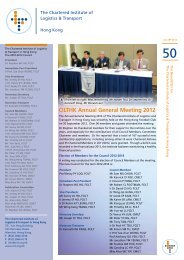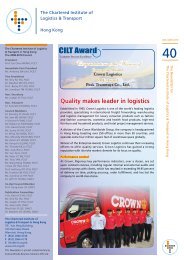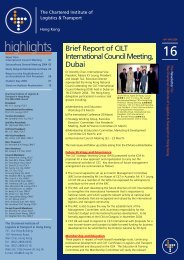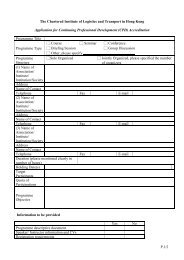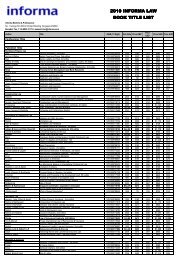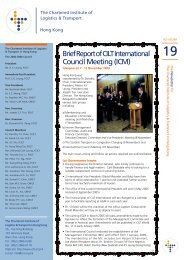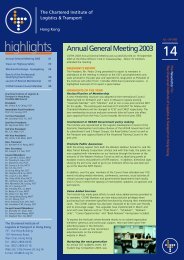to view file - The Chartered Institute of Logistics and Transport in ...
to view file - The Chartered Institute of Logistics and Transport in ...
to view file - The Chartered Institute of Logistics and Transport in ...
Create successful ePaper yourself
Turn your PDF publications into a flip-book with our unique Google optimized e-Paper software.
CILTHK Newsletter issue 9 03<br />
We want <strong>to</strong> ensure that companies<br />
have <strong>in</strong>centives <strong>to</strong> provide new<br />
services <strong>and</strong> raise st<strong>and</strong>ards; that<br />
taxpayers’ money is spent wisely <strong>to</strong><br />
make public transport available for all<br />
<strong>and</strong> that services are regulated <strong>in</strong> the<br />
public <strong>in</strong>terest.<br />
<strong>The</strong> way forward is through an<br />
<strong>in</strong>tegrated transport policy. This<br />
means <strong>in</strong>tegration: -<br />
• With<strong>in</strong> <strong>and</strong> between different<br />
types <strong>of</strong> transport, so that each<br />
works properly <strong>and</strong> people can<br />
make easy connections between<br />
them<br />
• With the environment, so that<br />
our transport choices cause less<br />
damage<br />
• With l<strong>and</strong> use plann<strong>in</strong>g, <strong>to</strong><br />
support more susta<strong>in</strong>able travel<br />
choices<br />
• With policies for education,<br />
health <strong>and</strong> wealth creation, so<br />
that transport helps <strong>to</strong> make a<br />
fairer, more <strong>in</strong>clusive society.<br />
F<strong>in</strong>e words but, <strong>of</strong> course, the<br />
challenge is <strong>to</strong> turn them <strong>in</strong><strong>to</strong> reality.<br />
<strong>The</strong> Global Dimension<br />
Urban transport is extraord<strong>in</strong>arily<br />
complex – but, by def<strong>in</strong>ition, it would<br />
seem <strong>to</strong> be local <strong>in</strong> nature, conf<strong>in</strong>ed<br />
by city boundaries. Although<br />
<strong>in</strong>creas<strong>in</strong>gly we live <strong>in</strong> a global world,<br />
we might assume that this is not<br />
relevant <strong>to</strong> the provision <strong>of</strong> urban<br />
transport. Metros, for example, do<br />
not compete for the same markets.<br />
However, urban transport is no<br />
longer self-conta<strong>in</strong>ed – for several<br />
reasons<br />
• First, because <strong>of</strong> the<br />
<strong>in</strong>terrelationship between longdistance<br />
rail <strong>and</strong> national <strong>and</strong><br />
<strong>in</strong>ternational aviation, <strong>and</strong><br />
urban distribution. Airports are<br />
<strong>in</strong>creas<strong>in</strong>gly look<strong>in</strong>g <strong>to</strong> develop<br />
rail l<strong>in</strong>ks <strong>to</strong> improve<br />
uncongested access.<br />
• More <strong>and</strong> more commuters<br />
around the world live <strong>in</strong> one<br />
community, <strong>of</strong>ten semi-rural,<br />
while travell<strong>in</strong>g long distances <strong>to</strong><br />
work <strong>in</strong> city centres.<br />
But globalization provides a yet more<br />
important impulse <strong>to</strong> the provision <strong>of</strong><br />
good urban transport. Major cities like<br />
London, New York, Tokyo are now<br />
‘world cities’ <strong>in</strong> every sense, <strong>and</strong> not<br />
just national headquarters. Paris,<br />
Frankfurt, Hong Kong are <strong>in</strong> the same<br />
category. I have no doubt that the<br />
terrorists who struck New York were<br />
very clear about its ‘world’ status.<br />
World cities compete <strong>to</strong> attract the<br />
world’s lead<strong>in</strong>g bus<strong>in</strong>esses, as well as<br />
the world’s <strong>to</strong>urists. A significant part <strong>of</strong><br />
this competition <strong>in</strong>volves the provision<br />
<strong>of</strong> high quality transport that is still, <strong>in</strong><br />
an age <strong>of</strong> electronic communication,<br />
essential <strong>to</strong> the well-be<strong>in</strong>g <strong>of</strong> urban life<br />
<strong>and</strong> efficiency. But globalization<br />
impacts urban transport for another<br />
reason – the globalization <strong>of</strong> the<br />
pr<strong>of</strong>essions.<br />
And we can be truly collaborative<br />
because the success <strong>of</strong> one <strong>of</strong> us does<br />
not imply the failure <strong>of</strong> another – as<br />
may be the case with global bus<strong>in</strong>esses<br />
such as the au<strong>to</strong>mobile <strong>in</strong>dustry or<br />
pharmaceuticals.<br />
Benchmark<strong>in</strong>g<br />
This has led us at Imperial College <strong>to</strong> be<br />
<strong>in</strong>volved <strong>in</strong> a unique benchmark<strong>in</strong>g<br />
exercise.<br />
<strong>The</strong> first metro <strong>in</strong> the world was opened<br />
<strong>in</strong> London <strong>in</strong> 1863. Some <strong>of</strong> the largest<br />
are <strong>of</strong> much more recent v<strong>in</strong>tage than<br />
London (Tokyo 1927, Moscow 1935,<br />
Hong Kong 1979).<br />
<strong>The</strong> Railway Technology Strategy Centre<br />
(RTSC) is part <strong>of</strong> the University <strong>of</strong><br />
London Centre for <strong>Transport</strong> Studies <strong>in</strong><br />
the Department <strong>of</strong> Civil <strong>and</strong><br />
Environmental Eng<strong>in</strong>eer<strong>in</strong>g at Imperial<br />
College. RTSC was established <strong>in</strong> 1992,<br />
assisted by fund<strong>in</strong>g from the then<br />
British Rail, as a centre <strong>of</strong> excellence<br />
serv<strong>in</strong>g the railway <strong>in</strong>dustry on<br />
strategic, technology <strong>and</strong> economic<br />
issues, <strong>in</strong> the UK <strong>and</strong> worldwide.<br />
<strong>The</strong> early years <strong>of</strong> the RTSC were<br />
dom<strong>in</strong>ated by projects <strong>in</strong> the UK,<br />
pr<strong>in</strong>cipally for British Rail but also for<br />
its successors <strong>in</strong> Railtrack, a roll<strong>in</strong>g<br />
s<strong>to</strong>ck leas<strong>in</strong>g company <strong>and</strong> others, as<br />
well as for London Underground.<br />
Recent years have seen RTSC broaden<br />
its <strong>in</strong>ternational client base while<br />
cont<strong>in</strong>u<strong>in</strong>g its position as a strategy<br />
<strong>and</strong> technology advisor <strong>to</strong> many <strong>of</strong><br />
the UK’s major rail <strong>in</strong>dustry<br />
enterprises.<br />
RTSC serves as a benchmark<strong>in</strong>g centre<br />
for two consortia <strong>of</strong> urban railways –<br />
CoMET (the Community <strong>of</strong> Metros),<br />
who are lead<strong>in</strong>g opera<strong>to</strong>rs <strong>of</strong><br />
underground railways (metros) around<br />
the world, <strong>and</strong> NOVA. <strong>The</strong>ir members<br />
are<br />
• CoMET - Berl<strong>in</strong>, Hong Kong<br />
(MTRC), London (LUL), Mexico<br />
City, Moscow, New York, Paris<br />
(RATP <strong>and</strong> RER), Sao Paolo,<br />
Tokyo<br />
<strong>and</strong><br />
• NOVA – Dubl<strong>in</strong>, Glasgow, Hong<br />
Kong (KCRC), Lisbon, Naples,<br />
Madrid, Oslo, S<strong>in</strong>gapore, Taipei,<br />
Tyne <strong>and</strong> Wear (Nexus).<br />
<strong>The</strong> benchmark<strong>in</strong>g studies are<br />
dedicated <strong>to</strong> assist<strong>in</strong>g metros <strong>to</strong><br />
identify <strong>and</strong> implement best practice<br />
through the application <strong>of</strong><br />
benchmark<strong>in</strong>g comparisons <strong>and</strong><br />
detailed case study evaluations.<br />
In 1989 an employee <strong>of</strong> the Xerox<br />
Corporation <strong>in</strong> the USA wrote a paper<br />
(Camp 1989) which def<strong>in</strong>ed the term,<br />
‘Benchmark<strong>in</strong>g - the search for<br />
<strong>in</strong>dustry best practices that lead <strong>to</strong><br />
superior performance’. Xerox had<br />
been <strong>in</strong> a fierce competitive battle<br />
with the Japanese, whose approach<br />
was gradually <strong>to</strong> improve<br />
performance by gett<strong>in</strong>g the most out<br />
<strong>of</strong> exist<strong>in</strong>g resources. This has been<br />
described by some, not the Japanese,<br />
as ‘mak<strong>in</strong>g the assets sweat’.<br />
It is important <strong>to</strong> recognize that<br />
comparisons <strong>of</strong> bus<strong>in</strong>ess processes lie<br />
at the heart <strong>of</strong> benchmark<strong>in</strong>g. <strong>The</strong><br />
need for data collection <strong>and</strong><br />
comparison can lead <strong>to</strong> an erroneous<br />
focus on the production <strong>of</strong> ‘league



